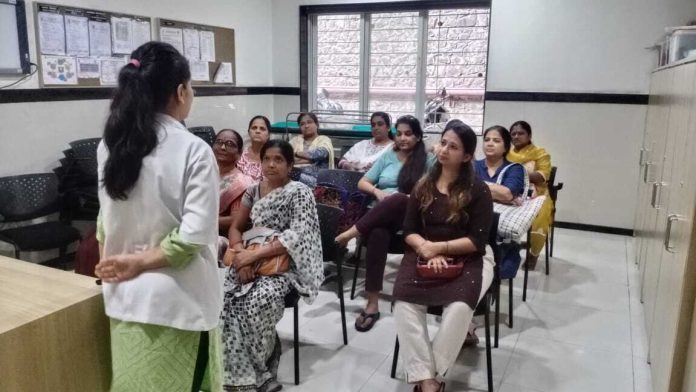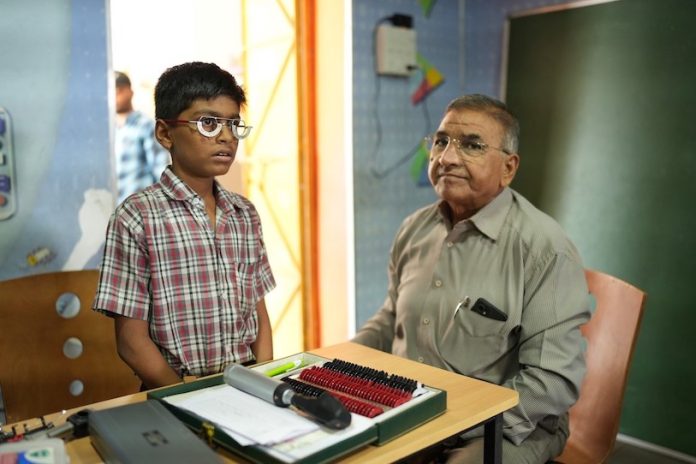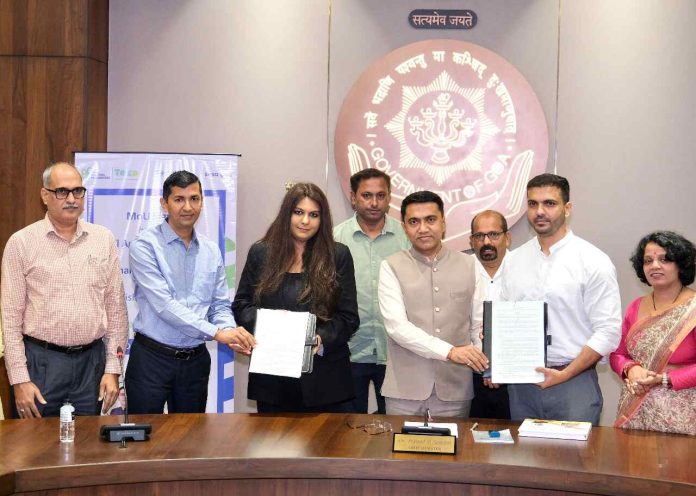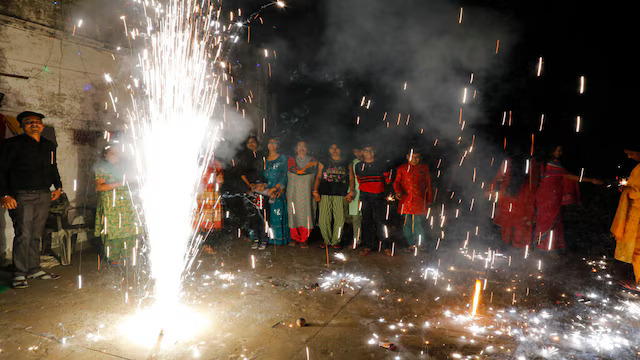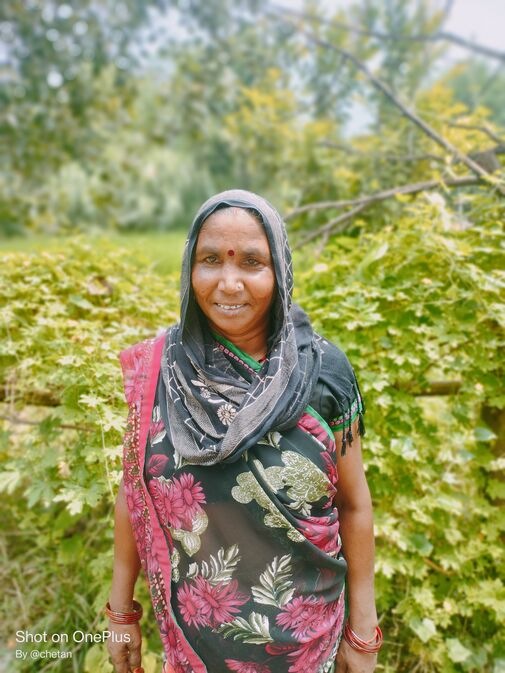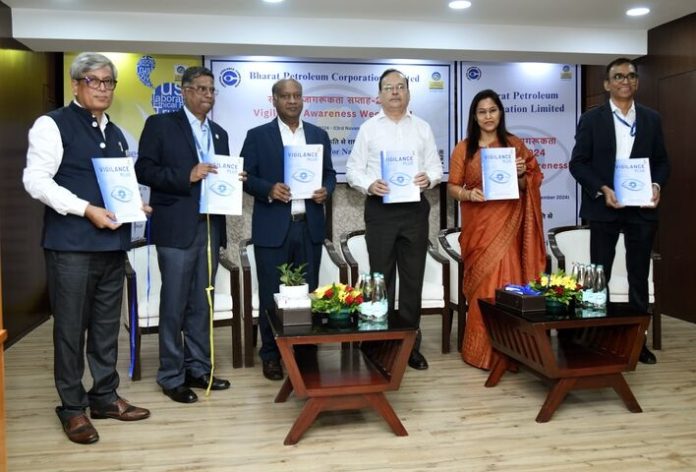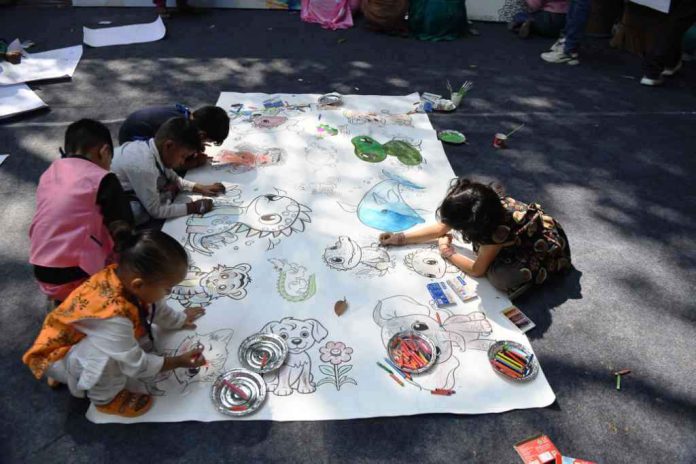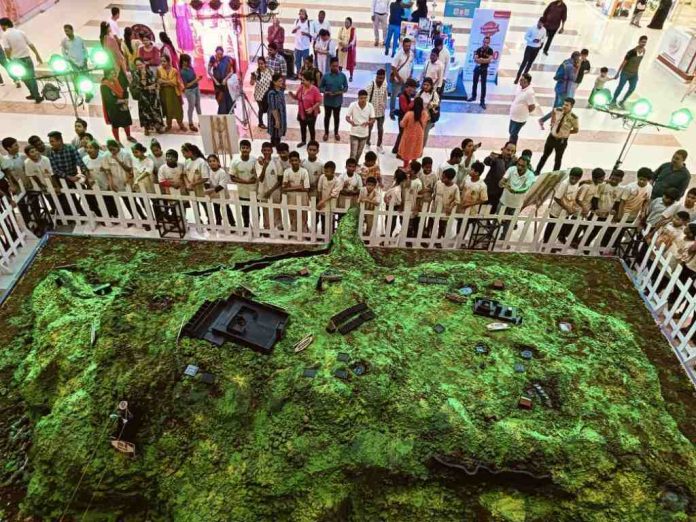‘Gift of Sight’ CSR Initiative Launched to Bridge Learning Gap Amongst Students
At ConveGenius.AI, Diwali means more than lighting diyas—it’s about lighting up lives. This year, their 500+ team members embraced the spirit of the festival by offering something truly transformative—the Gift of Sight. Through their ‘Gift of Sight’ campaign, ConveGenius kick-started a country wide initiative to empower students with clear eyesight and bridge the learning gap across India.
ConveGenius’s AI-driven reading assessments on their SwiftChat platform had recently uncovered a challenge that extended beyond literacy—many students struggled due to uncorrected vision issues. Motivated by these findings, the team launched the campaign to provide these children with custom-made spectacles, bringing clarity not just to their view of the world but to their studies.
Studies like those from The Lancet Global Health Commission show that up to 80% of a child’s learning is visual, so poor eyesight can quietly erode confidence and success in the classroom. ConveGenius’s Gift of Sight initiative, therefore, isn’t just about glasses—it’s about empowering these students to learn and grow without barriers.
As part of this initiative, the first eye-screening camp was organised for over 5,000 students across Gujarat, providing much-needed eyeglasses to help overcome a silent barrier to learning.
“Clear vision is fundamental to a child’s journey in education, and we’re dedicated to removing any obstacles to ensure that every child has the opportunity to succeed,” shares Jairaj Bhattacharya, Co-founder and Managing Director of ConveGenius. “Together, let’s make this Diwali a celebration of change, potential, and possibility,” Bhattacharya continues.
The impact of initiatives like this stretches beyond immediate educational benefits. As Amartya Sen states in Development as Freedom, “ill health is a major cause of poverty, as it restricts both physical productivity and the acquisition of skills.” In the long term, providing children with the necessary healthcare tools to succeed in their education directly influences their future earning potential and, by extension, the nation’s economic strength. Improved health outcomes among students lead to a skilled and empowered workforce, which in turn drives economic development and poverty alleviation.
For the ConveGenius team, this campaign was more than an act of kindness—it was a reflection of their mission to empower children with resources to thrive. Each team member chose to sponsor a child’s eye checkup and eyeglasses, knowing that this small gesture could brighten a student’s future in profound ways.
As children received their glasses, joy lit up their faces, a moment that resonated deeply with the ConveGenius team. This Diwali, ConveGenius did more than provide eyeglasses—they opened up new possibilities for these students, enabling them to read, learn, and see their dreams with newfound clarity.
Disclaimer: This media release is auto-generated. The CSR Journal is not responsible for the content.
गोवा को रेबीज मुक्त बनाने के लिए आगे आया अनिल अग्रवाल फाउंडेशन, गोवा सरकार से साझेदारी
वेदांता ग्रुप के सामाजिक सेवा की यूनिट अनिल अग्रवाल फाउंडेशन (Anil Agrawal Foundation) ने गोवा सरकार (Goa News) के संखली म्युनिसिपल काउंसिल के साथ एक समझौता किया है। इस साझेदारी का उद्देश्य गोवा को रेबीज मुक्त बनाना और पशु कल्याण में सुधार करना है। Anil Agrawal Foundation की प्रमुख पहल द एनिमल केयर ऑर्गनाइजेशन (TACO), इस मिशन को संचालित करेगी। इस परियोजना के अंतर्गत बिचोलिम तालुका में एक अत्याधुनिक पशु कल्याण केंद्र स्थापित किया जाएगा, जिसका निर्माण दो एकड़ में होगा, जो संखली म्युनिसिपल काउंसिल द्वारा उपलब्ध कराई गई है।
आवारा पशुओं की समस्या पर गोवा सरकार कर रही है काम
इस केंद्र की स्थापना का मुख्य उद्देश्य गोवा को रेबीज-मुक्त बनाना और आवारा कुत्तों और बिल्लियों की आबादी को नियंत्रित करना है। परियोजना का पहला चरण एनिमल बर्थ कंट्रोल सेंटर स्थापित करना है, जिसमें आवारा कुत्तों और बिल्लियों के लिए नसबंदी सेवाएं और एंटी-रेबीज टीकाकरण ड्राइव शामिल होंगी। गोवा में बढ़ती आवारा पशुओं की समस्या पर नियंत्रण पाने के उद्देश्य से गोवा सरकार लगातार प्रयासरत है। 20वीं पशुधन जनगणना के अनुसार, गोवा में आवारा कुत्तों की संख्या में 70.68% की वृद्धि हुई है, जिससे यह संख्या अब 27,864 हो गई है। इन आवारा कुत्तों के कारण कई बार रेबीज जैसी बीमारियों का खतरा बना रहता है और बच्चों तथा बुजुर्गों के लिए यह खतरे का कारण बनते हैं। TACO का उद्देश्य है कि इन समस्याओं को नियंत्रित कर एक स्वस्थ समुदाय का निर्माण किया जाए।
अनिल अग्रवाल फाउंडेशन पशुओं के उपचार में करेगा मदद
The Animal Care Organisation का यह Animal Birth Control Centre पशुओं के उपचार में अत्याधुनिक सुविधाएं प्रदान करेगा। इस केंद्र में ऑपरेशन के पहले और बाद में पशुओं की देखभाल के लिए विशेष क्षेत्र बनाए गए हैं। नसबंदी के बाद पशुओं को सुरक्षित और स्वस्थ तरीके से रिकवरी में मदद मिलेगी। इसके बाद इस केंद्र में एक आधुनिक पशु चिकित्सा अस्पताल भी स्थापित किया जाएगा, जिसमें आउट पेशेंट डिपार्टमेंट (OPD), ऑपरेटिंग थियेटर्स (OT), और डायग्नोस्टिक सेवाएं शामिल होंगी। इससे गोवा में पशुओं को उत्कृष्ट चिकित्सा सेवा उपलब्ध कराई जाएगी।
इसके साथ ही, इस पशु कल्याण केंद्र में एक प्रशिक्षण सुविधा भी उपलब्ध होगी, जहां पशु चिकित्सा विशेषज्ञों, पशु प्रेमियों, NGO, और स्थानीय समुदायों के लिए विशेष प्रशिक्षण सत्र आयोजित किए जाएंगे। यह पहल समाज को पशु कल्याण के प्रति अधिक जागरूक बनाएगी और स्थानीय लोगों को पशु देखभाल में सक्रिय भूमिका निभाने के लिए प्रेरित करेगी।
देश के कई राज्यों में एनिमल वेलफेयर पर काम करता है अनिल अग्रवाल फाउंडेशन
TACO का यह कदम ‘वन हेल्थ’ के सिद्धांत पर आधारित है। इस दृष्टिकोण के साथ, TACO ने हरियाणा, राजस्थान और असम जैसे राज्यों में भी पशु नसबंदी, टीकाकरण, और वन्यजीव संरक्षण कार्यक्रम जैसे प्रयास किए हैं। इसके अतिरिक्त, TACO ने हरियाणा के फरीदाबाद में एक मल्टी-स्पेशलिटी पशु चिकित्सा अस्पताल की भी स्थापना की है, जो आपातकालीन सेवाओं, मोबाइल स्वास्थ्य वैन और एम्बुलेंस सेवाओं से लैस है।
BMC restricts bursting firecrackers after 10 pm during Diwali in Mumbai, issues guidelines
With Mumbai’s air quality dipping lately, the Brihanmumbai Municipal Corporation (BMC) has banned bursting of firecrackers after 10 p.m. during the ongoing Diwali festivities. The Mumbai civic body has issued new guidelines to restrict the use of firecrackers during Diwali and at the same time urged citizens to follow the same in order to combat air pollution in the city.
The civic body has deployed monitoring squads in all the 26 municipal wards to keep an eye on violators flouting dust mitigation norms. Additionally, the BMC has suggested precautionary measures for citizens such as bursting firecrackers only in open spaces, avoiding crowded areas and keeping an eye on children. It has appealed to the citizens to celebrate Diwali in an eco-friendly manner.
Combating pollution and addressing health risks
“To keep a check on air and noise pollution, the timing for the bursting crackers has been limited till 10 pm in Mumbai on the day of Diwali. Citizens are urged to burst crackers that would cause minimum sound and air pollution,” the BMC mentioned in a statement.
“With air pollution increasing rapidly across the country, Mumbai’s air quality has also deteriorated significantly. People burst firecrackers during Diwali, which contributes to air pollution. Therefore, firecrackers should be burst in as small a quantity as possible to reduce air and noise pollution. Air pollution caused by firecrackers is causing great distress to infants, pregnant women, the elderly, and people suffering from asthma. It is important to follow the guidelines to avoid health-related problems,” the statement further reads.
In case there is a fire emergency, citizens have been urged to call 101 or the civic helpline 1916, as recommended by the Mumbai Fire Department of the Municipal Corporation of Greater Mumbai (BMC).

BMC Do’s and Don’ts
The BMC also published a list of Do’s and Don’ts to be followed by citizens during Diwali festivities
Do’s
Wear thick cotton clothes while bursting crackers.
Firecrackers should be kept away from children and should be accompanied by adults while bursting.
Always use footwear while bursting crackers.
Keep a bucket full of water nearby while lighting firecrackers and, in case of burns, immediately pour plenty of clean water on the burned area.
Don’ts
Firecrackers should not be burst inside the building and on the staircase.
Avoid using match boxes or lighters to light firecrackers.
Firecrackers should not be burst in the air near trees, overhead electric wires or tall buildings.
Do not place lamps near window curtains.
Do not burst firecrackers near electric wires, gas pipelines or parking lots.
While setting up electrical lighting decorations at home or in buildings, seek help from certified technicians and ensure the setup is not overloaded.
This Diwali, let safety be our first spark! ✨
Let’s follow the essential instructions issued by the Brihnmumbai Municipal Corporation’s Mumbai Fire Brigade to double the joy of the Diwali
Celebrate a Clean and safe Diwali together!🪔#MyBMCUpdates #DiwaliSafety… pic.twitter.com/7j64nlrwZ3
— माझी Mumbai, आपली BMC (@mybmc) October 30, 2024
Monitoring dust mitigation norms
Apart from appealing to citizens, the municipal body has also deployed ground level teams in all the 26 municipal wards who will monitor dust mitigation norms. Over the past one week, notices have been issued to over 15 contractors operating mostly in Andheri and Bandra areas over flouting BMC norms, as per sources. CCTV cameras are also being installed in construction sites, to record whether all the dust mitigation norms are being followed.
Prime Minister Launches an Extension of the Ayushman Bharat for the Elderly
Prime Minister Narendra Modi, on October 29, rolled out a health cover scheme for all aged 70 years and above. This launch was an expansion of the Ayushman Bharat Pradhan Mantri Jan Arogya Yojana (AB PM-JAY). According to the new extension, all senior citizens are expected to receive Rs.5 lakh annual coverage, per family. About six crore people from 4.5 lakh families are to benefit from this scheme, irrespective of their income.
Even though the scheme was a policy decision by the government, the Prime Minister took a dig at two opposition-ruled states, West Bengal and Delhi, as they decided to opt out of the scheme. These two states will not roll out this extension of AB PM-JAY. However, analysis done by a daily newspaper The Indian Express shows that about 45% of hospitalisations carried out under the scheme were from opposition-ruled states: Tamil Nadu, Karnataka, Kerala, Punjab, Jharkhand, Himachal Pradesh, and Telangana.
“I apologise to the people over 70 years from Delhi and West Bengal that I will not be able to serve you. I apologise because- I will come to you know that you are suffering. I will get the information, but I will not be able to help you. The reason is that the Delhi and West Bengal governments are not joining the Ayushman Bharat scheme. I’m prevented from serving older people of Delhi and West Bengal. Because of politics. I am painted”, said the prime minister.
What is the Scheme About?
While addressing an event at ‘Ayurveda Day’ in Delhi, the prime minister of India launched the senior citizen extension to the AB PM-JAY scheme. The extension aims to significantly reduce out-of-pocket expenses for low-income households. This extension of AB PM-JAY, only for senior citizens, will open the door to essential medical treatment and emergency care that were earlier unfordable. Earlier AB PM-JAY was income-based, providing Rs.5 Lakh to all eligible families. But under the expanded scheme, all 70+ will get an additional top-up cover of Rs. 5 lakh per year for themselves. Politically too, the impact of this extension will be visible more in the marginalised sections and therefore will garner trust for the Modi government.
Health is a primary union government subject and therefore this scheme is an important decision by the Modi government. As per the expanded scheme, all eligible beneficiaries will be issued an Ayushmann Vaya Vandana card. Simultaneously, a separate portal to register the elderly will be functional by Tuesday. Now, all beneficiaries can register at the nearest Ayushmann Kendra or can even do the process online via the Ayushmann NHA app.
Other than the expansion of the health scheme, the Prime Minister also launched the U-WIN portal. The portal will digitally manage vaccination, tracking two vaccines for pregnant women and 11 vaccines for children.
The Scheme in Different States
Data from the Union Health Ministry on funds spent on the health scheme by different states highlight how required financial relief was provided to families who could otherwise not afford any specialised treatment. For example, in Tamil Nadu, the funds were diverted towards general surgery, paediatric medicine and general medicine. In the state of Karnataka, the majority of the same funds were used in cardiology, cardio and vascular surgery and neurosurgery. While in the northern states of Punjab, funds were diverted mostly towards orthopaedics, general surgery and cardiology. The state of Jharkhand concentrated its funds towards ophthalmology, general surgery and general medicine.
The funds used by the scheme vary as per different states. This is because there is a highly differential healthcare need across all the states of India and the scheme is flexible to adjust.
However, in West Bengal, the already rolled out ‘Swastha Saathi’ state health scheme makes the Centre’s AB PM-JAY an unnecessary policy intervention. This state scheme gives Rs. 5 Lakh health insurance cover a year and has currently enrolled approximately 2.4. crore families. For this reason, the state has decided to push itself out of the AB PM-JAY. However, it could not do that peacefully without achieving backlash from the Prime Minister of the country.
The AB PM-JAY is an important scheme beyond political battles and electoral lip service. It is a mega health scheme in India that has the potential to create a difference. Alongside, it also aims to make healthcare more affordable, which currently cannot be taken up by the poor.
Empowering Rural Entrepreneurs of Gudur through SHGs
ACC, the cement and building material company of the diversified Adani Portfolio, along with the Adani Foundation, is enabling rural entrepreneurship across Gudur Gram Panchayat near ACC Tikaria. Along with the Adani Foundation, the Company has set up 12 Self-Help Groups (SHGs) to transform the socio-economic landscape of the village.
Gudur Gram Panchayat, with a population of about 2,000, used to face significant socio-economic challenges, with most villagers engaged in agriculture and labour, often struggling below the poverty line. Essential services like hospitals, banks, and markets are located over 13 km away, making access difficult for many.
ACC, through the Adani Foundation’s intervention, formed and nurtured 12 Self-Help Groups (SHGs) in the village. By providing microfinance and business training, the initiative has uplifted many families, enabling them to improve their livelihoods.
Sundra, a 54-year-old woman, has transformed her life through community-driven microfinance, receiving Rs. 1.50 lakh from her SHG to invest in farming equipment. This venture, under the National Rural Livelihood Mission (NRLM), now provides her with a stable monthly income of Rs. 15,000, significantly enhancing her family’s living conditions.
ACC and the Adani Foundation’s impact through this initiative is seen in the empowerment story of villagers including Sundra, who have turned challenges into opportunities, fostering economic growth, and uplifting their rural communities.
Disclaimer: This media release is auto-generated. The CSR Journal is not responsible for the content.
BPCL Inaugurates Vigilance Awareness Week 2024
Bharat Petroleum Corporation Limited (BPCL), a prestigious ‘Maharatna’ and Fortune Global 500 Company, inaugurated Vigilance Awareness Week 2024 (VAW-2024) on 28th October at its Corporate Office, reinforcing its commitment to ethical practices and integrity in business. The event, themed “Culture of Integrity for Nation’s Prosperity,” is being observed from October 28 to November 3 across BPCL’s operations nationwide, with a series of activities designed to raise awareness and foster vigilance among all employees.
The inaugural ceremony was led by Chief Guest Shri Dinesh Kumar Jain, Ex-Chief Secretary of Maharashtra and Ex-Member Lokpal, who joined BPCL leadership including Smt. Meenaxi Rawat, IES, Chief Vigilance Officer; Shri V.R.K. Gupta, Director (Finance); Shri Raj Kumar Dubey, Director (HR); Shri S. Srikanth, Chief General Manager (Vigilance), and other senior officials. In a symbolic moment, Smt. Meenaxi Rawat administered the Integrity Pledge, uniting BPCL officials across India through a live webcast to affirm their dedication to honesty and transparency.
In a message to employees, Shri G. Krishnakumar, Chairman and Managing Director, BPCL highlighted Bharat Petroleum’s commitment to ethics, integrity, and accountability, which are fundamental to its operations. He stated that this week serves as a vital reminder of our dedication to fostering a corruption-free workplace. He also lauded Smt Meenaxi Rawat and her vigilance team, for their ongoing dedication to promoting the values of ethics and integrity.
In her address, Smt. Meenaxi Rawat highlighted India’s ranking in the Corruption Perception Index, emphasizing the need for continuous improvement in ethical practices. She reffered Ethisphere’s annual rankings, which reveal that ethical companies often outperform the market, a testament to BPCL’s core values of Ethics and Trust. BPCL’s commitment to transparency was evident in the recent integration of all policies and guidelines on a centralized intranet webpage, streamlining access across all business units. Citing the success of the Public Grievance Portal, Smt. Rawat emphasized the importance of a robust complaint-handling system, adding that vigilance is not only a function of vigilance officers but a shared responsibility across BPCL’s workforce.
Chief Guest Shri Dinesh Kumar Jain, in his keynote, elaborated on the foundational values of honesty and integrity. Sharing an anecdote from Sweden involving a Member of Parliament meticulously distinguishing between personal and official expenses, Shri Jain illustrated how simple acts of accountability reinforce integrity. He outlined the formula for understanding corruption as “Corruption equals Monopoly plus Discretion minus Accountability,” highlighting how the Government of India has tackled corruption with measures like Direct Benefit Transfer (DBT) and faceless Income Tax assessments. Commending BPCL’s Integrity Clubs in schools, he emphasized the value of instilling ethics in young minds.
To mark the occasion, three significant publications were launched: The Vigilance Officer’s Handbook, Do’s & Don’ts Handbook for Officers, and the Vigilance Newsletter, which are expected to enhance vigilance practices within BPCL.
Vigilance Awareness Week 2024 will continue with a series of events and initiatives, aimed at promoting a strong culture of integrity and vigilance across BPCL’s operations, fostering a resilient, transparent corporate ethos for sustainable growth.
Disclaimer: This media release is auto-generated. The CSR Journal is not responsible for the content.
Top CSR Projects in Karnataka
Karnataka is a state that ranks significantly higher in the country for its environmental sustainability. The state ranks first in generation of hydroelectricity and is also among the states with above average forest cover. Karnataka is also popular among tourists for its lush coffee plantations and delicious cuisine.
Bengaluru in Karnataka has become an IT hub in the last several years. Some of the top IT companies of the world have an office in Bengaluru and are hiring the top talents of the country. This has made Karnataka, and especially Bengaluru, a desirable destination for investment of CSR funds.
The Government of Karnataka is planning to formulate a policy as per which corporates operating within the state will have to direct their Corporate Social Responsibility funds to education. Karnataka Deputy Chief Minister D.K. Shivakumar recently spoke about this while addressing corporate sector representatives at the 47th Annual General Meeting of the Bangalore Chamber of Industry and Commerce (BCIC). According to the minister, the move will help address employment issues in the state.
In FY2022-23, Karnataka received Rs. 1985.55 Cr. through various CSR initiatives from 2534 companies. The top three areas of focus for the CSR programs were: education, health and environment, with an expenditure of Rs. 1110.16 Cr., Rs. 377.82 Cr., and Rs. 307.25 Cr. respectively in them. The top three spenders in the state included Infosys Limited (Rs. 180.4 Cr.), Biop Steels and Power Private Limited (Rs. 141 Cr.), and Wipro Limited (Rs. 117.68 Cr.).
Top CSR Projects in Karnataka
L&T Finance Limited’s Jal Vaibhav 2.0
L&T Finance Ltd. (LTF), one of the leading Non-Banking Financial Companies (NBFCs) in the country, has launched its Corporate Social Responsibility (CSR) project, ‘Jalvaibhav 2.0’, in the Mulbagal Taluk of Kolar district, Karnataka. The initiative focuses on integrated water resource management to create additional water harvesting capacity, benefiting over 5,000 farmers across 12 villages.
The Jalvaibhav 2.0 project addresses water scarcity and soil health improvement through various initiatives, such as replenishing existing and new water resources, promoting climate-smart agri, and allied interventions. These efforts will directly impact farmers’ income levels while spreading awareness and training on sustainable practices.
Mulbagal Taluk, located in the Kolar district, has a semi-arid climate with hot summers and scant rainfall, characterised by an average annual rainfall of 760 mm over 50 days. The region’s over-reliance on groundwater has led to severe agricultural challenges, including poor soil quality, erratic monsoon patterns, and frequent dry spells. This has resulted in rapid depletion of groundwater levels, aggravating the existing agricultural issues and highlighting the need to address the three critical components of drought-proofing: ensuring water availability, optimising water use, and securing water entitlements.
Digital classrooms set up by UWB and AMD
United Way Bengaluru (UWB) in partnership with Zila Panchayat, Davangere supported by Advanced Micro Devices India Pvt. Ltd. (AMD), has set up digital classrooms enhancing coaching for students in Davangere district. These smart classrooms have been set up in 21 Pre-University Government colleges in the district.
The Joint Entrance Examination (JEE) by the National Testing Agency (NTA) under the Ministry of Education (MoE), Govt. of India is the basis for students entering the engineering stream. Considered as one of the toughest examinations in India, the JEE is the gateway for pursuing engineering as a career for students. In recent years, the quality of coaching has become a crucial factor in the probability of students getting a college and stream of their choice. Many students have to move cities to get quality training which uproots them from their family and local communities; it is also a large financial burden for the families to sustain such an effort. These barriers are a key reason many students find it difficult to score well in the JEE.
Recognizing this gap in the system, the Zila Panchayat, Davangere embarked on bringing world-class infrastructure available in the metros to Davangere by expanding access to technology with new smart classrooms. The ease of access and locally available infrastructure aim to bring quality training infrastructure to those who otherwise could not afford to travel to metros and to girls who have an interest but could not find coaching infrastructure locally.
It is anticipated that more than 6500 students studying in Davangere will benefit from these digital classrooms.
City-Farmer Partnership project by Godrej Properties Limited
Godrej Properties Limited, India’s leading real estate developer, partnered with the Chikkaballapur City Municipal Council (CMC) and the Indian Institute for Human Settlements (IIHS) for the City-Farmer Partnership project in Chikkaballapur, Karnataka to address the city’s waste management challenges and to promote scientific management of solid waste.
Focused on converting organic wet waste into valuable compost for farmers, approximately 759 tonnes of legacy waste was semi-processed into organic compost and supplied to 109 farmers across 17 villages of Chikkaballapur. The compost, processed from 1,000 cubic meters of waste, was provided at no cost to encourage the adoption of organic farming practices. Additionally, more than 569 tonnes of segregated wet waste has been processed through collaboration with 81 farmers.
A key aspect of this initiative and Godrej Properties’ focus is fostering a symbiotic relationship between urban and rural communities. To enhance and educate the farmer communities and stakeholders on the benefits of sustainable waste management practices, IIHS conducted multiple training sessions for more than 100 farmers on converting municipal waste into organic compost. Additionally, 45 CMC staff members were trained on key aspects of waste management. The training focused on the importance of segregated waste collection and transportation for the success of the city-farmer partnership project.
A series of ward-level and feedback meetings have been conducted as part of the City-Farmer Partnership for the Solid Waste Management (SWM) project to promote waste segregation at source. These meetings have been attended by CMC officials, the IIHS project team, Anganwadi workers, volunteers engaged in monitoring door-to-door collection of waste, and about 50 residents from each ward. To drive home the messaging and create awareness at the ground level, six street plays and a road show traversed key streets in Chikkaballapur, engaging citizens and commercial establishments with messages about the benefits of waste separation.
Cancer screening and treatment by Merck
Merck, a global leader in science and technology, has established strategic partnerships in India with the Rashtreeya Sikshana Samithi Trust, a not-for-profit organization and the HCG Foundation a unique not-for-profit initiative of HCG – South Asia’s largest cancer care network. These collaborations aims at facilitating free cancer screening and treatment support to rural areas of Karnataka, Maharashtra and Gujarat.
Continuing its focus on enhancing access to cancer care, Merck and the Rashtreeya Sikshana Samithi Trust are working together to raise awareness about cancer care and provide treatment to people in approximately 600 villages in Karnataka. So far, under this initiative, 933 people have been screened, 60 have received diagnostic support, 106 have been identified with pre-cancerous lesions, 68 have been treated for non-cancerous oral ailments, and 2 people diagnosed with cancer have been provided with referral support.
These initiatives will offer people in the targeted areas, free consultations and lab investigations such as Sugar Tests, BP and BMI measurements, along with physical oral check-ups, Trismus testing, and screenings through digital apps, to assess their overall health, potential risk factors, pre-cancerous lesions and offer counselling on the next appropriate actions.
ABB India’s educational programs
ABB India’s educational programs as part of its CSR initiatives support inclusive and equitable education. These programs, which were being run in 98 schools in Nelamangala, will now also expand to 50 schools in Peenya starting this academic year reaching a total of 148 schools and around 10,000 students from Peenya and Nelamangala.
The STEM Awareness and Foundational Literacy and Numerical Skills Program is aimed at supporting young students with essential scientific concepts and foundational and age-appropriate skills in literacy and numeracy alongside STEM topics. Integrated within the school timetable, it provides hands-on learning opportunities, making learning interactive and highly engaging. Run in partnership with Sikshana Foundation, the program aims to elevate the education level by equipping primary and higher primary students with the much-needed competencies essential for their cognitive development.
Paryavaran Mitra, the other program, will be launched soon, and run in collaboration with the Centre for Environment Education (CEE). It aims to prepare higher primary school students to face environmental sustainability challenges by engaging them in eco-friendly activities in school and its surroundings. The state’s Department of Education is actively involved in the program design and implementation covering critical themes such as water and sanitation, waste management, energy, etc. This would help students move beyond schools and classrooms, connecting them with nature, society, and communities.
These initiatives, launched in 2022, have successfully raised awareness levels among students, bridging the aspiration gap in key scientific concepts. Thorough assessments, done periodically, signal a gradual progress in the students’ capabilities and awareness levels. 98 teachers from Nelamangala block have been trained and provided with upgraded concepts and supplemental resources to effectively deliver the programs. Students across all grades participate in STEM activities under teacher supervision. A similar teacher training and orientation program shall be implemented in the current initiation year in the Peenya block.
Seed-to-mouth initiative by Herbalife
Herbalife India, a global health and wellness company, partnered with Sambhav Foundation, a non-profit organization, to train and empower farmers in India as part of its CSR initiative. Through Herbalife’s Seed-to-Mouth initiative, the organization has strengthened the farming capabilities of over 9,300 farmers across India. In line with Herbalife’s commitment to the United Nations’ Sustainable Development Goals (SDGs), the comprehensive training program has transformed over 25,000 households across 84 villages in Karnataka, Rajasthan, and Madhya Pradesh.
The project was implemented across major districts such as Ajmer (Rajasthan), Vijayapura (Karnataka), and Vidisha (Madhya Pradesh), equipping the farming community with cutting-edge agricultural learning resources, reducing operating costs, and enabling market reach to enhance their income generation. Since its launch in July 2022, the Seed-to-Mouth initiative has enhanced sector access for farmers by connecting them with major industry players, enabling them to reach a wider customer base and expand their market reach.
The NGO conducted a diagnostic study in consultation with over 50 agri-experts across the states to identify and address existing gaps in agricultural practices by providing farmers with essential resources such as seeds, equipment, fertilizers, and loans. Farmers also gained practical knowledge on essential topics such as advanced farming technology, crop diversification, safe use of chemicals, land management, credit support, and market access through collaboration with Krishi Vigyan Kendras and university incubators. Expert-led awareness sessions on farming and irrigation supported farmers throughout the farming process.
Rejuvenation of Hunasamaranahalli Lake by Lowe’s India
Lowe’s India announced the successful rejuvenation of the Hunasamaranahalli Lake in the north of Bengaluru. The project began in 2022, in partnership with Oasis Foundation and HandsonCSR.
The Hunasamaranahalli Lake, near the Bengaluru International Airport, was home to migratory birds, a huge population of fish, snakes and turtles, primarily. However, with a fast-growing neighborhood, the lake started to suffer from soil erosion, depleting water retention capacity and garbage accumulation.
As part of the rejuvenation, Lowe’s India supported a number of enhancements including de-silting, the addition of bunds around the lake, the planting of 1000-plus trees and flowering plants, refurbishment of inlet and outlet sources and the creation of a new walking and cycling path along the lake’s perimeter. Additionally, Lowe’s India associates led cleanup drives, including garbage collection and weed removal, in areas surrounding the lake.
The rejuvenated lake is expected to bring back lost biodiversity in the surrounding areas and save more than 3,00,015.9Kgs of CO2 by 2043. It has already started attracting butterflies, birds and other smaller creatures. More than 500 people visit the lake daily.
DIKSHa Program by Dalmia Bharat
Dalmia Bharat Foundation (DBF), the CSR arm of Dalmia Bharat Ltd initiated DIKSHa program in 2016 in partnership with the National Skill Development Corporation. DIKSHa is dedicated to enabling skill development and sustainable livelihoods for disadvantaged youth in rural communities in India.
In a country with the youngest and largest workforce in the world, India faces the challenge of significant skill gaps, with only 5% of the workforce recognized as formally skilled. Addressing this concern, DBF via DIKSHa provides placement-linked, short-term skill training to youth and women, adding them to skilled workforce for enhanced income.
DIKSHa primarily focuses on training unemployed youth or youth with limited prospects by enhancing their employability through skill development. DIKSHa offers training in a wide range of areas, including healthcare, industrial sewing machine operator, assistant electrician, customer relationship management, sales and marketing, data entry operator, beauty and wellness, and unarmed security. Till date, DIKSHa has trained 11647 individuals successfully with more than 8271 individuals placed in gainful employment, earning monthly wages ranging from INR 8,000 to INR 20,000.
Nanhe Kadam Bal Utsav hosted in New Delhi to celebrate Early Childhood Development
New Delhi, India: Mobile Creches, a leading non-profit organization dedicated to early childhood development (ECD), successfully hosted “Nanhe Kadam Bal Utsav” – a knowledge fair celebrating the critical early years of a child’s life at the National Crafts Museum C Hastkala Academy, New Delhi today. The event showcased innovative approaches to childcare, learning, and development, aimed at fostering a nurturing environment for children from vulnerable communities. Held in commemoration of 29th October celebrated every year as the International Day of Care and Support, the event brought together childcare champions, policymakers, parents and children, and the general public to honor the significant contributions of these individuals in shaping young lives.
The event was graced by Dr. Shamika Ravi, Member of the Economic Advisory Council to the Prime Minister, Dr. Radhika Batra, Founder and President of Every Infant Matters, and Ms. Suhela Khan, UN Women as guests contributing to the celebrations with their inspiring words and support.
The Utsav was filled with interactive activities and fun-filled engagements, including ECD stalls, fun activities, children’s story corner, drawing area, and a photo exhibition. Performances like Kathputli dance, a Nukkad Natak (street play), and a drum circle captivated audiences and highlighted the importance of a holistic approach to child development.
The day began with a welcome address by Ms. Sumitra Mishra, CEO of Mobile Creches, who emphasised the significance of the early years and Mobile Creches’ role in supporting children and families from disadvantaged communities. She said, “Through the Nanhe Kadam Bal Utsav, we celebrate the potential of every child and the unwavering efforts of parents and care- workers who lay the foundation for a brighter future.”
One of the highlights of the event was the launch of a model creche aimed at creating exemplary childcare centres. The Model Creche was inaugurated by Dr Radhika Batra, who lauded the Mobile Creches’ initiative and its vision of elevating childcare standards in India. “Mobile Creches’ dedication to child rights advocacy is truly inspiring, providing vulnerable children with the essential love, care, and guidance they need to thrive. The reach of this model across 15 states in India showcases its transformative potential, and I believe it could serve as a powerful framework for regions worldwide, including Africa and Latin America, where many children face similar challenges. I look forward to exploring opportunities to collaborate and expand this life-changing approach, ensuring more children benefit from the remarkable efforts of Mobile Creches.” she remarked.
An awards ceremony recognised the dedication of 12 childcare champions from the states of Chhattisgarh, Jharkhand, Odisha and West Bengal including caregivers and sarpanchs who have demonstrated exceptional commitment to children’s well-being. The awards were presented by Dr. Shamika Ravi.
Dr. Shamika Ravi congratulated the recipients for their crucial role in building the foundation of the nation. “On average, women aged 18 to 60 spend nearly five hours daily on caregiving. As society progresses, market solutions have emerged for many needs, but not for care. Even when we hire help, nothing replaces a mother’s care, and the level of care remains a concern. Despite increasing education levels, with 45 percent of STEM graduates being women, many face career setbacks due to childcare responsibilities. FORCES’ efforts are a vital step toward addressing this. True progress requires men’s support in caregiving, and the government must recognize this as a significant issue across all wealth groups. Childcare is not optional; it’s essential. We applaud Mobile Creches for their impactful work.”
The event concluded with a lively musical performance by Manzil Mystics, celebrating the joy and creativity of the early childhood years.
The “Nanhe Kadam Bal Utsav” was a resounding success, bringing together students, teachers, care-workers, and community members to celebrate and advocate for improved childcare practices in India.
Disclaimer: This media release is auto-generated. The CSR Journal is not responsible for the content.
CSR initiative ‘2024 Heritage Awareness through Mud Fort Making Competition’ hosted at Thane
Thane, India: In a vibrant celebration of Maharashtra’s cultural heritage, Kalpataru, a leading real estate developer, supported Killekars’, dedicated efforts in preserving State’s historic forts. Under Kalpataru’s Corporate Social Responsibility (CSR) initiative, series of workshops were organised to create awareness on Forts of Maharashtra, of which the ‘2024 Mud Fort Making Competition’ held especially for students was held at Korum Mall, Thane. This CSR project aimed to promote heritage awareness, engage the community, and foster environmental responsibility.
The competition brought together students from local schools and residents of housing societies as part of the Thane Smart City initiative, encouraging them to participate in the ancient craft of mud fort-making. The activity sought to revive this traditional art form, which has gradually diminished with the rise of technology and digital entertainment. Through hands-on participation, the project aimed to reignite interest in Maharashtra’s heritage and inspire younger generations to embrace local traditions.
A detailed replica of the iconic Raigad Fort—the capital of Chhatrapati Shivaji Maharaj’s Maratha Empire—was created within the mall, attracting significant public engagement and disseminating information on the preservation & conservation of Forts in Maharashtra. This installation paid tribute to the 351st anniversary of the coronation ceremony of Chhatrapati Shivaji Maharaj and provided a meaningful way for visitors to connect with Maharashtra’s history.
“Through this initiative, we aim to rekindle interest in Maharashtra’s rich heritage and create a meaningful connection with our roots while creating awareness about safeguarding our monuments for the future generations. We believe in building more than just spaces—we build legacies, and this activity aligns with our commitment to safe, timeless, and sustainable communities,” said Anagha Poojari, CSR Head, Kalpataru Limited
The event also promoted environmental responsibility, focusing on waste management, cleanliness, and sustainability. By involving children and local residents in creative activities, it encouraged participants to adopt sustainable practices and develop a sense of environmental awareness
The partnership between Kalpataru and Killekars reflects their shared commitment to preserving the cultural significance of Maharashtra’s forts. This initiative exemplifies Kalpataru’s philosophy of giving back to the community while keeping traditions alive, providing opportunities for people to come together and celebrate in meaningful ways.
The enthusiastic response from participants at Korum Mall highlighted the power of community-driven initiatives to foster connections and preserve heritage. Such ensure that Maharashtra’s cultural traditions remain vibrant and relevant, allowing them to be passed down to future generations.
Disclaimer: This media release is auto-generated. The CSR Journal is not responsible for the content.

